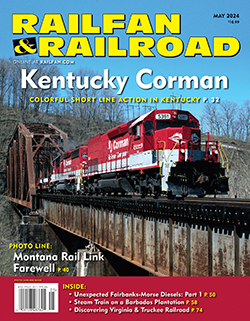by Gordon Lloyd, Jr./photos from the Lloyd Transportation Library
The Fairbanks-Morse Company of Beloit, Wis., built a line of sturdy diesel locomotives spanning three decades, though actual production spanned only 20 years. Its catalog provided offerings for many Class I railroads, with options for freight, passenger, and switching assignments. Of the five major North American locomotive builders of the era, including American Locomotive Company, Baldwin Locomotive Works, the Electro-Motive Division of General Motors, and Lima, Fairbanks-Morse stood alone with its opposed-piston engine family. The prime movers offered for locomotive production were adapted from a line of highly successful opposed-piston engines that powered many U.S. Navy submarines during World War II.
Whereas the restrictions during the war managed by the War Production Board often resulted in unanticipated diesel locomotives in a railroad fleet, those constraints were eliminated at the end of hostilities. In those nascent days of postwar expansion, Fairbanks-Morse began a serious effort to market its unusual engine design in a standardized line of its own locomotives.
ABOVE: Apache Railroad H10-44 number 200 models its original silver and red paint in Snowflake, Ariz., on a cool February 18, 1975, with snow in evidence on the ground. Number 200 was the second of two H10-44s for the 70-mile railroad. —Keith E. Ardinger – LTL
Successful models of competitor locomotives were already employed at railroads across North America, particularly in the U.S. Fairbanks-Morse made a gutsy decision to challenge the likes of EMD, Alco, and Baldwin, all well entrenched in demanding railroad service.
Switchers were constructed at the company’s Beloit facility, but initially road locomotive production was outsourced to General Electric at Erie, Pa., where the so-called “Erie Builts,” were constructed; in those pre-U25B years, GE was not considered an opponent or threat, merely a manufacturing site with locomotive-building capability. A total of 111 A- and B-units were constructed in Pennsylvania before all locomotive production was anchored in Wisconsin.
ABOVE: At McKees Rocks, Pa., on August 26, 1961, Pittsburgh & Lake Erie H10-44s 9100 and 9103, along with an unidentified third F-M, displayed their final numbers and “New York Central System” lettering. —Kenneth L. Souglas – LTL
Upstart F-M relied on Westinghouse for electrical equipment, which was later provided by GE. However, F-M previously had a line of its own rotating electrical equipment, whose inclusion bolstered the potential for F-M revenue.
Fairbanks-Morse diesels have been documented in numerous books and periodicals over the years, but generally as a constituent of larger railroads. The F-M units used by short lines, industrials, military operators, and the secondhand market have been less chronicled. And, for the purpose of this study, Class I railroads which merely sampled a small group have been included — we’ll randomly set that bar at “about a dozen” or so units, which were too often overlooked by camera-toting historians as they dutifully documented railroad operations throughout the 1950s and 1960s.
ABOVE: A chance encounter on a chilly Thursday, February 20, 1964, brought the author’s father and D&RGW 122 together in Salt Lake City. When seeking these four Rio Grande H10-44s, numbers 120–123, Roper Yard was always a safe bet. —Gordon E. Lloyd – LTL
By the 1970s and 1980s, remaining F-Ms were themselves a focus of those same camera-toting historians as the breed became ever scarcer. Credit the likes of Jerry Pinkepank, Louis A. Marre, Dave Ingles, Ken Douglas, Dick Will, Dave Hamley, and the magazine Extra 2200 South published by Don and Dan Dover, for their collective efforts in diesel locomotive enlightenment.
In the Beginning
Domestic sales began in August 1944 as World War II raged in Europe and the Pacific. The Milwaukee Road took delivery of the first unit, H10-44 1802. Chicago & North Western, Union Pacific, and Santa Fe also sampled a single unit before the end of hostilities; a fifth unit, also for The Milwaukee Road, rounded out that wartime manufacture. The production is noteworthy to the extent that this would have been approved by the War Production Board, which managed and controlled production and matériel during the war years…
Read the rest of this article in the May 2024 issue of Railfan & Railroad. Subscribe Today!
The post The Unexpected Fairbanks-Morse: Part 1 appeared first on Railfan & Railroad Magazine.
